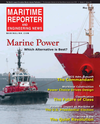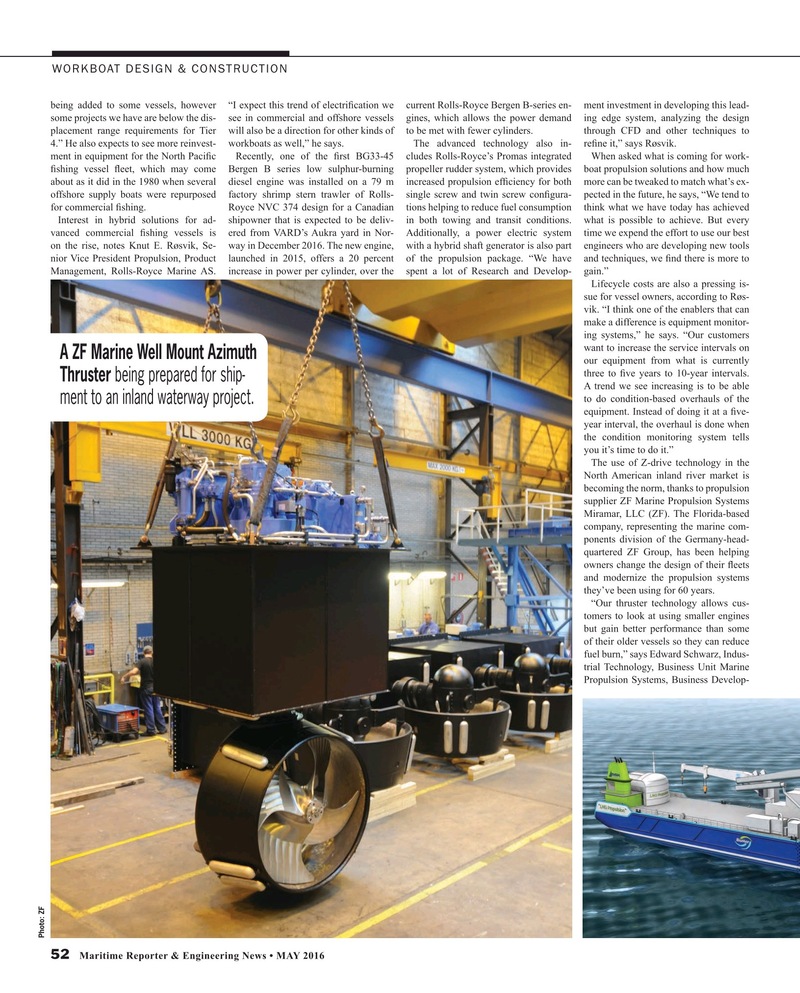
Page 52: of Maritime Reporter Magazine (May 2016)
The Marine Propulsion Edition
Read this page in Pdf, Flash or Html5 edition of May 2016 Maritime Reporter Magazine
WORKBOAT DESIGN & CONSTRUCTION being added to some vessels, however “I expect this trend of electri? cation we current Rolls-Royce Bergen B-series en- ment investment in developing this lead- some projects we have are below the dis- see in commercial and offshore vessels gines, which allows the power demand ing edge system, analyzing the design placement range requirements for Tier will also be a direction for other kinds of to be met with fewer cylinders. through CFD and other techniques to 4.” He also expects to see more reinvest- workboats as well,” he says. The advanced technology also in- re? ne it,” says Røsvik.
ment in equipment for the North Paci? c Recently, one of the ? rst BG33-45 cludes Rolls-Royce’s Promas integrated When asked what is coming for work- ? shing vessel ? eet, which may come Bergen B series low sulphur-burning propeller rudder system, which provides boat propulsion solutions and how much about as it did in the 1980 when several diesel engine was installed on a 79 m increased propulsion ef? ciency for both more can be tweaked to match what’s ex- offshore supply boats were repurposed factory shrimp stern trawler of Rolls- single screw and twin screw con? gura- pected in the future, he says, “We tend to for commercial ? shing. Royce NVC 374 design for a Canadian tions helping to reduce fuel consumption think what we have today has achieved
Interest in hybrid solutions for ad- shipowner that is expected to be deliv- in both towing and transit conditions. what is possible to achieve. But every vanced commercial ? shing vessels is ered from VARD’s Aukra yard in Nor- Additionally, a power electric system time we expend the effort to use our best on the rise, notes Knut E. Røsvik, Se- way in December 2016. The new engine, with a hybrid shaft generator is also part engineers who are developing new tools nior Vice President Propulsion, Product launched in 2015, offers a 20 percent of the propulsion package. “We have and techniques, we ? nd there is more to
Management, Rolls-Royce Marine AS. increase in power per cylinder, over the spent a lot of Research and Develop- gain.”
Lifecycle costs are also a pressing is- sue for vessel owners, according to Røs- vik. “I think one of the enablers that can make a difference is equipment monitor- ing systems,” he says. “Our customers want to increase the service intervals on
A ZF Marine Well Mount Azimuth our equipment from what is currently three to ? ve years to 10-year intervals.
Thruster being prepared for ship-
A trend we see increasing is to be able to do condition-based overhauls of the ment to an inland waterway project.
equipment. Instead of doing it at a ? ve- year interval, the overhaul is done when the condition monitoring system tells you it’s time to do it.”
The use of Z-drive technology in the
North American inland river market is becoming the norm, thanks to propulsion supplier ZF Marine Propulsion Systems
Miramar, LLC (ZF). The Florida-based company, representing the marine com- ponents division of the Germany-head- quartered ZF Group, has been helping owners change the design of their ? eets and modernize the propulsion systems they’ve been using for 60 years.
“Our thruster technology allows cus- tomers to look at using smaller engines but gain better performance than some of their older vessels so they can reduce fuel burn,” says Edward Schwarz, Indus- trial Technology, Business Unit Marine
Propulsion Systems, Business Develop-
Photo: ZF 52 Maritime Reporter & Engineering News • MAY 2016
MR #5 (50-57).indd 52 5/2/2016 10:48:48 AM

 51
51

 53
53
